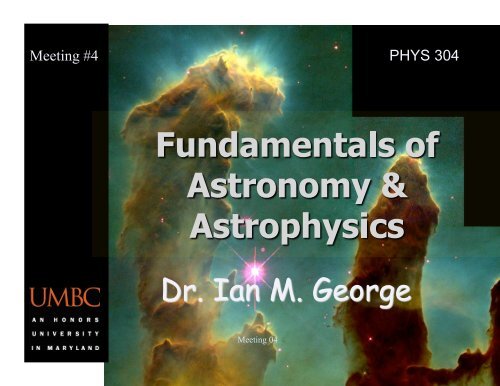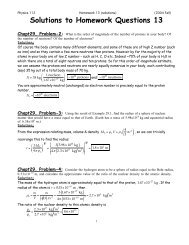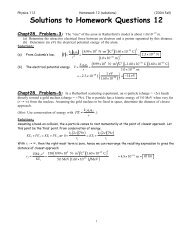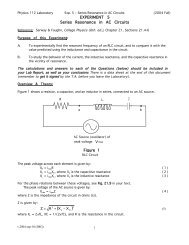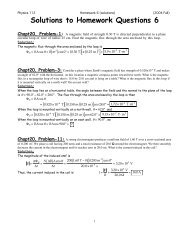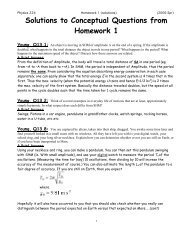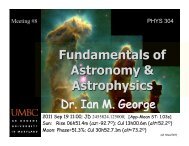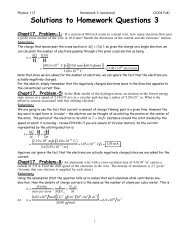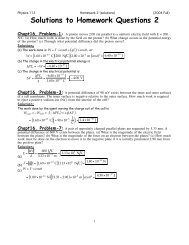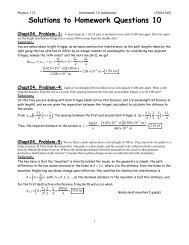PDF Slides - UMBC
PDF Slides - UMBC
PDF Slides - UMBC
You also want an ePaper? Increase the reach of your titles
YUMPU automatically turns print PDFs into web optimized ePapers that Google loves.
Meeting #4<br />
PHYS 304<br />
Meeting 04
[Image Credit: Bodmas.org]<br />
NCP<br />
Zenith<br />
Hour Angle h<br />
…from the definitions<br />
An object’s hour angle<br />
(& hence transit or culmination)<br />
can be calculated from<br />
RA (α) if LST (Θ) known:<br />
ϒ<br />
RA α<br />
h = Θ − α<br />
…or of course the LST (Θ) can be calculated trivially<br />
if the RA (α) of objects passing through an<br />
observer’s N-S meridian is known at a given instance…<br />
Ian M. George PHYS 304 (2011 Fall) Meeting 04
[Image Credits: Stellarium]<br />
… right now<br />
(~11:00 EDT, Sept 9 th )<br />
@<strong>UMBC</strong><br />
(lat ϕ~40 O )<br />
objects with<br />
α~9h 00m<br />
are culminating (looking South)<br />
ie. Θ~9h 00m<br />
… so γ (α=0 O , δ=0 O ) passed through<br />
our N-S meridian ~2am (local)<br />
this morning<br />
with a (max) altitude a max ~50 O<br />
… by coincidence<br />
Uranus is currently at (α~0 O , δ=0 O )<br />
Ian M. George<br />
PHYS 304 (2011 Fall)
[Image Credits: Stellarium]<br />
… from current LST (Θ~9h 00m)<br />
… know γ (α=0 O , δ=0 O ) passes through<br />
our N-S meridian ~2am (local)<br />
around this time of year<br />
… thus can easily determine Altair<br />
(α~20h, δ=+8 O )<br />
ie. with an RA<br />
~ 20 hours “after” γ<br />
or ~ 4 hours “before” γ<br />
culminates at ~10pm (local)<br />
Ian M. George PHYS 304 (2011 Fall) Meeting 04
…relationship between systems can be expressed as..<br />
Hour Angle<br />
(in degrees etc)<br />
cosh = − tanδ tanφ +<br />
declination<br />
sin a<br />
cosδ cosφ<br />
altitude of object<br />
geogrpahic<br />
latitude of<br />
observer<br />
…you will be given this expression if you need it!<br />
…objects “rise” and “set” when a = 0 O of course<br />
…hence when<br />
cosh = − tanδ tanφ<br />
…so given δ and ϕ can calculate h for rise and set<br />
…and given α can use Θ = h + α<br />
…to calculate the sidereal time<br />
of the rise or setting<br />
Ian M. George PHYS 304 (2011 Fall) Meeting 04
… Altair (α~20h, δ=+8 O ) from <strong>UMBC</strong> (lat ϕ~40 O ) today/tonight<br />
Source will rise or set when cosh = − tanδ tanφ ~ - 0.12<br />
( )<br />
h = cos −1 − 0.12<br />
so Sidereal time of rise and set given by<br />
ie Θ r/s ~ 26.5hr or ~13.5 hr<br />
ie.<br />
but we also know that currently (~11:30 EDT)<br />
Θ ~ 9.5hr<br />
~ +/- 97.4 O<br />
which is equivalent to ~ +/- 6.5 hr<br />
Θ = h + α<br />
..hence Altair will cross local horizon<br />
~4.0 hr and ~17 hr in the future<br />
ie at ~3:30pm (EDT) this afternoon [when actually still light of course]<br />
& ~4:30am (EDT) tomorrow morning<br />
Also Note: ~10pm culmination [found previously]<br />
half way between these times (of course!)<br />
Ian M. George PHYS 304 (2011 Fall) Meeting 04
… again its usually best to choose a coordinate system<br />
that best suits ones specific needs<br />
… hence there are other coordinate systems which are<br />
sometimes more appropriate<br />
… a moderately common examples are<br />
The Ecliptic Coordinate System<br />
and the<br />
The Galactic Coordinate System<br />
both are again spherical systems<br />
just with different Origins and<br />
different “special directions”<br />
Ian M. George PHYS 304 (2011 Fall) Meeting 04
Origin: Sun<br />
“Special Direction #1” – Ecliptic Plane<br />
“Special Direction #2” – ϒ<br />
Spatial coordinates:<br />
Ecliptic Latitude (β) angle “up” from the ecliptic<br />
plane<br />
Ecliptic Longitude (λ) angle around the ecliptic plane<br />
from ϒ (counterclockwise)<br />
… useful for objects in the Solar system<br />
Ian M. George PHYS 304 (2011 Fall) Meeting 04
Origin: Sun<br />
“Special Direction #1” – Galactic Plane<br />
“Special Direction #2” – direction of the Galactic Center<br />
Spatial coordinates:<br />
Galactic Latitude (b) angle “up” from the galactic<br />
plane<br />
Galactic Longitude (l) angle around the galactic plane<br />
from G.C (counterclockwise)<br />
… useful for objects in (duh!) the Galaxy<br />
Ian M. George PHYS 304 (2011 Fall) Meeting 04
… so say you have..<br />
Target position in<br />
Coord System #1<br />
(eg (α,δ) in Eq.Sys @ defined time)<br />
and<br />
Your Position<br />
(eg long, lat & local time on Earth)<br />
Coordinate<br />
Transformations<br />
Any<br />
Necessary<br />
Corrections<br />
Target position in<br />
Coord System #2<br />
(eg (alt,az) in Horiz.Sys )<br />
at desired time<br />
Ian M. George PHYS 304 (2011 Fall) Meeting 04
… which corrections are really necessary depends upon<br />
the accuracy one requires<br />
(often all the corrections certainly are not always required since other<br />
effects can dominate the accuracy that can be achieved)<br />
1) Shape of the Earth [text Sect.2.2]<br />
Earth is not a perfect sphere<br />
radius towards equator ~ 21.4 km larger than that to poles<br />
thus corrections to account for observer’s pos n req d<br />
2) Parallax & Aberration due to Orbit & Spin of the Earth<br />
[text Sect.2.9,10]<br />
Nearby objects will appear to move against more<br />
distant objects due to annual & diurnal parallax<br />
Special relativity: aberration due to Earth’s motion (
… and this is a biggie …<br />
3) Precession of the Earth’s spin axis [text Sect.2.2]<br />
Since Earth’s shape is an oblate spheroid<br />
and it’s spin axis is tilted to the ecliptic<br />
(and also at ~5 O to the orbital plane of the moon)<br />
there are gravitational torques on the Earth<br />
due to the Sun & Moon (& the other planets)<br />
…eg. Sun trying to pull equatorial bulge into plane of the ecliptic<br />
… result is the direction of the spin axis moves<br />
around on a circular path every ~26,000 years<br />
“precession” (~50”/yr clockwise)<br />
Ian M. George PHYS 304 (2011 Fall) Meeting 04
Tilt angle stays (approx) constant<br />
as a result ….<br />
the North Celestial Pole<br />
moves in a circle<br />
(of “radius” ~23.45 O )<br />
“around” the sky<br />
obviously<br />
the Celestial Equator<br />
also moves<br />
[Image Credit: Pearson Education]<br />
Ian M. George PHYS 304 (2011 Fall) Meeting 04
Celestial North “moves” against the sky with time<br />
Celestial Equator “moves” against the sky with time<br />
… so the location the Vernal Equinox<br />
“moves” against the sky with time<br />
But these directions form the basis of our whole<br />
Equatorial Coordinate System (α,δ) !!!<br />
Solution:<br />
Quote (α,δ) at a precisely defined time<br />
- and make corrections for the date & time<br />
of the desired observation<br />
[see text pp38-40 for precession matrix calcs]<br />
Ian M. George PHYS 304 (2011 Fall) Meeting 04
For the last few years…<br />
The precisely defined time is<br />
noon (UTC) on 2000 Jan 01<br />
(ie. JD 2,451,545.0 – more of this later)<br />
Thus one often sees “(J2000)” after equatorial coords<br />
(and some other time-dependent quantities)<br />
Example:<br />
the (α,δ) of the Galactic Center<br />
are α = 266.405100 O , δ = -28.936175 O (J2000)<br />
… which as noted already is more often written as<br />
17h 45m 37.224s, -28 O 56’ 10.23” (J2000)<br />
Right Ascension<br />
in time units<br />
Declination<br />
in angular units<br />
Ian M. George PHYS 304 (2011 Fall) Meeting 04
… this can be quite a biggie too for some stars …<br />
4) Proper Motion of Objects [text Sect.2.2]<br />
No object in the Universe is “stationary”<br />
(& “stationary” can’t be defined on its own anyhow of course)<br />
… thus even after correcting for the spin & orbit of the Earth<br />
all objects are moving with respect to our chosen<br />
coordinate system<br />
(unless it was the basis of our coordinate system of course)<br />
Proper Motion is the term used to describe the<br />
“velocity” of objects “on the plane of the sky”<br />
it is almost always quoted in arcsec/yr (few “/yr for nearest starts)<br />
obviously given the direction of motion<br />
is trivial to correct (α,δ) (J2000) for observation date<br />
Ian M. George PHYS 304 (2011 Fall) Meeting 04
… for ground-based observations …<br />
5) Refraction caused by the Atmosphere [text Sect.2.9]<br />
… can approximate atmosphere as a set of layers - see Fig 2.20<br />
each with different index of refraction n i<br />
n 2<br />
sin z 2<br />
= n 1<br />
sin z 1<br />
…etc<br />
but n i depends on density (temperature, pressure) etc<br />
so current conditions: difficult to predict exactly…<br />
… simple parameterizations often used<br />
to get initial, best-guess estimates<br />
Ian M. George PHYS 304 (2011 Fall) Meeting 04
[Image Credits: Mike-Willis.com, aoptics.co.uk, asterism.com]<br />
… for “typical” conditions, towards<br />
the horizon effect leads to ~34’<br />
increase in apparent altitude<br />
(so Sun has already set<br />
when appears to set)<br />
Ian M. George PHYS 304 (2011 Fall) Meeting 04
A final problem for ground-based observations<br />
(again esp in the optical band)<br />
is again due to the atmosphere.<br />
The atmosphere can be thought of consisting of many<br />
packets or bubbles of air in motion.<br />
… many of these will be along the line of sight to a target,<br />
with slightly different optical characteristics & motions<br />
… this results in the image of the target appearing to<br />
move slightly & vary in brightness on short timescales<br />
(…why stars “twinkle”)<br />
In “good seeing” the effect is < 1arcsec<br />
but in “bad seeing” conditions the effect can be many 10s of arcsec<br />
Ian M. George PHYS 304 (2011 Fall) Meeting 04
[Image Credit: Michael Richmond]<br />
Turbulent “bubbles” of air<br />
@ different heights in the<br />
Atmosphere<br />
… each with slightly different<br />
optical characteristics<br />
& motion<br />
apparent<br />
position<br />
time<br />
Can result in the apparent position of<br />
the target moving on detector (in 2-D)<br />
on short timescales<br />
Ian M. George PHYS 304 (2011 Fall) Meeting 04
… even spin axis wobbles (v.slightly) on short timescales<br />
[Image Credits: http://hpiers.obspm.fr/]<br />
Ian M. George PHYS 304 (2011 Fall) Meeting 04
Obviously we all know the units:<br />
seconds, minutes, hours, months, years etc<br />
And that 1 second is a fundamental SI units<br />
defined to be 9,192,631,770 periods of the radiation emitted by transitions<br />
between the two hyperfine levels of the ground state of a 55 Cs 133 atom<br />
… and that 1 minute is 60 seconds, 1 hour is 60 minutes…<br />
… but what exactly do we mean by a “day”,<br />
a “month”<br />
& a “year” ?!?<br />
- remember, due to the corrections mentioned previously,<br />
we need to make sure we precisely define these…<br />
Ian M. George PHYS 304 (2011 Fall) Meeting 04
there are<br />
24 hours in a “Day”,<br />
(for historical reasons)<br />
between 28 & 31 Days in a Month<br />
and<br />
12 months in a Year<br />
which turns out to be<br />
365 days in a Year, and 366 days in a Leap Year<br />
which occurs every 4 years,<br />
when the year is exactly divisible by 4,<br />
except for the “0 th year” of each century,<br />
unless that the “0 th year” is itself exactly divisible by 4<br />
… why so “messy”..?!!<br />
Ian M. George PHYS 304 (2011 Fall) Meeting 04
Additional Slide [not shown in class]<br />
While we have a fundamental unit of time for science<br />
- the second which is now well defined [& accepted]<br />
via an atomic transition (hyperfine levels of grd state of 55 Cs 133 )<br />
[& have atomic clocks accurate to 1 part in 10 14 per day]<br />
.. this unit is not that practical for “everyday” use<br />
- desire & practical usefulness to divide “time”<br />
into ‘bite-sized’ units (hours, days, years etc…)<br />
BUT<br />
also want these ‘bite-sized’ units to be related to astronomy!<br />
… for practical reasons we want the units we’ve named<br />
“days” & “years” to be related to the Sun.<br />
[this is very convenient in everyday life!]<br />
..and we want to have these ‘bite-sized’ units<br />
to be integer multiples of each other [60s in an “hour” etc]<br />
[this is also very convenient in everyday life!]<br />
Ian M. George PHYS 304 (2011 Fall) Meeting 04
Additional Slide [not shown in class]<br />
..obviously Physics neither ‘knows’ or ‘cares’ about human convenience!<br />
… eg. there is no reason why the Earth<br />
has to spin an integer (eg exactly 365 “days”) number of times<br />
every complete orbit of the Sun (ie 1 “year”)<br />
… this and other effects make keeping<br />
practical “wall-clock time” (UTC)<br />
in agreement with ‘celestial time’ a challenge<br />
… and numerous time systems can be defined<br />
all of which are based upon practical need<br />
Dennis Hopper: Apocalypse Now:<br />
You can't travel in space, you can't go out into space, you<br />
know, without, like, you know, uh, with fractions, okay?<br />
…Disagree – there are a lot of fractions in space <br />
Ian M. George PHYS 304 (2011 Fall) Meeting 04
Sidereal Time is based upon the rotation of the Earth<br />
1 sidereal day is defined to be the time taken for a non-solar system<br />
object to return to exactly the same azimuth<br />
(in the horizontal Coord system)<br />
… hence LST discussed previously..<br />
Solar Time is based upon the rotation of the Earth<br />
and its orbit around the Sun<br />
1 solar (or synodic) day is defined to be the time taken for the<br />
Sun to return to exactly the same az (in horizontal Coord sys)<br />
A Solar Day is 24 hrs (on average!)<br />
A Sidereal Day is 23 hrs 56 mins 4.09 seconds (on average!)<br />
Ian M. George PHYS 304 (2011 Fall) Meeting 04
Solar Day is longer<br />
than Sidereal Day<br />
since Earth has to<br />
rotate an extra ~1 O<br />
Distant<br />
star<br />
Sun<br />
Earth<br />
1 Sidereal year<br />
is 365.2564 d<br />
[Image Credit: Pearson Education]<br />
Ian M. George PHYS 304 (2011 Fall) Meeting 04
[Image Credit: Pearson Education]<br />
View from “above”<br />
the ecliptic<br />
Sun<br />
Earth<br />
Solar Day is longer<br />
than Sidereal Day<br />
since Earth has to<br />
rotate an extra ~1 O<br />
obviously!<br />
360 O orbit of Earth<br />
takes ~365 days<br />
hence Earth moves<br />
~1 O per day<br />
around orbit<br />
.. But Note:<br />
fact that Earth’s spin is in same sense<br />
as Earth’s orbital motion<br />
(ie counterclockwise when view from “above”)<br />
24 × 60<br />
also that ~ 4 min<br />
365<br />
Ian M. George PHYS 304 (2011 Fall) Meeting 04
ut Solar Time is actually a bit tricky …<br />
- Earth’s orbit is an ellipse<br />
so speed is not constant throughout orbit<br />
- Sun moves on ecliptic, not celestial equator<br />
so dα/dt ≠ constant<br />
Solution: introduce an hypothetical “Mean Sun”<br />
which moves around the around the celestial<br />
equator at a constant angular velocity<br />
…hence 24x60x60 = 86,400 s<br />
in a Mean Solar Day throughout the year<br />
[even this actually changes slowly with time!]<br />
Ian M. George PHYS 304 (2011 Fall) Meeting 04
Additional Slide [not shown in class]<br />
…Sundial will show “real” Local Solar Time<br />
….Correction to Mean Solar Time given by the “equation of time”…<br />
[Image Credit: HartRAO]<br />
….number of minutes<br />
to be subtracted from<br />
Local Solar Time<br />
to obtain<br />
Mean Solar Time<br />
Note<br />
Tilt: 6 month period<br />
Orbit: 12 month period<br />
Ian M. George PHYS 304 (2011 Fall) Meeting 04
Additional Slide [not shown in class]<br />
is actually not that easy in detail ….<br />
- Earth’s rotation rate is slowly decreasing<br />
- Precession of the spin axis<br />
- plus additional wobbling due to “Nutation”<br />
(caused by precession of Moon’s orbit around the ecliptic every 18.6 yrs)<br />
- and other effects<br />
Hence even Sidereal Time is not constant with “time”<br />
due to all these effects<br />
but corrections can be calculated & applied<br />
Mean Sidereal Time (“UT0” & variations)<br />
often used<br />
eg. “Greenwich Mean Sidereal Time”<br />
or “Universal Time”<br />
Ian M. George PHYS 304 (2011 Fall) Meeting 04
Additional Slide [not shown in class]<br />
Universal Time (UT0) is based on Mean Sidereal Time<br />
as specified at Greenwich (GMST)<br />
Terrestrial Time (TT) is based upon atomic clocks, and<br />
corrects for relativistic effects due<br />
to motion of the Earth.<br />
Julian Date (JD) is number of days from noon UT<br />
starting from noon Jan 1 st , 4713BCE (!)<br />
(this class held on JD ~2455814.152778)<br />
Modified Julian Date (MJD), for convenience, is simply<br />
= JD – 2400000.5 (begins at midnight)<br />
(so class held on MJD ~55813.652778)<br />
Ian M. George PHYS 304 (2011 Fall) Meeting 04
Additional Slide [not shown in class]<br />
a Julian Year is 365.25 days (SI abbreviation ‘a’)<br />
a Tropical Year<br />
is the time taken for the Sun to move from<br />
one Vernal Equinox to the next<br />
ie. RA of Sun increases by 24.00000… hr<br />
365.2422 days long (J2000 each with 86400s)<br />
…used as the basis of civil calendar corrections in the west<br />
…but tropical day actually getting longer 1.5 ms /century<br />
a Sidereal Year<br />
is the time taken for the Sun to make<br />
one revolution wrt background stars<br />
365.2564 days long (J2000 each with 86400s)<br />
(longer due to precession – also varies)<br />
Ian M. George PHYS 304 (2011 Fall) Meeting 04
Additional Slide [not shown in class]<br />
Coordinated Universal Time (UTC) is related to<br />
atomic-clock time (TAI) and is ‘corrected’<br />
to take into account all effects<br />
Leap seconds<br />
added as required<br />
to keep difference<br />
between 2 systems<br />
< ± 0.9s<br />
Usual ‘practical’ time system used<br />
(on wall clocks etc)<br />
Ian M. George PHYS 304 (2011 Fall) Meeting 04
Additional Slide [not shown in class]<br />
[Image Credits: http://hpiers.obspm.fr/]<br />
Ian M. George PHYS 304 (2011 Fall) Meeting 04
Additional Slide [not shown in class]<br />
… message to the<br />
worldwide<br />
“keepers of time”….<br />
Ian M. George PHYS 304 (2011 Fall) Meeting 04
Additional Slide [not shown in class]<br />
Ian M. George PHYS 304 (2011 Fall) Meeting 04
Additional Slide [not shown in class]<br />
vote in 2012 Jan!<br />
Ian M. George PHYS 304 (2011 Fall) Meeting 04
Additional Slide [not shown in class]<br />
… “Months” based on the Moon’s orbit around the Earth<br />
But just as for Earth- Sun system …<br />
… have to distinguish<br />
Synodic Month (from new moon to next new moon)<br />
29.53059 d<br />
from<br />
Sidereal Month (from fixed location on sky, back to same location)<br />
27.32158 d<br />
Earth’s rotation, orbit & Moon’s orbit<br />
also why high tides are 24hr 50min apart<br />
(not 24hrs exactly)<br />
Ian M. George PHYS 304 (2011 Fall) Meeting 04
Additional Slide [not shown in class]<br />
..in everyday life…<br />
..hence 12:00 “Zulu”<br />
Ian M. George PHYS 304 (2011 Fall) Meeting 04
Additional Slide [not shown in class]<br />
.. Not adopted by all states (or countries)<br />
.. Not adopted on same date(s) by all countries(!)<br />
.. “daylight saving time”<br />
eg.<br />
EST (UTC-5 hrs)<br />
vs EDT (UTC-4 hrs)<br />
etc<br />
.. USA: EDT starts second Sunday in March<br />
EST starts first Sunday in November<br />
Europe: Daylight saving Time<br />
stats last Sunday in March<br />
ends last Sunday in October etc etc<br />
Ian M. George PHYS 304 (2011 Fall) Meeting 04
Additional Slide [not shown in class]<br />
Choice of best Spatial & Temporal Coords to use<br />
depends upon application & desired accuracy<br />
Know the definitions of the (alt, az) and (α,δ)<br />
spherical coord systems<br />
Know the definitions of (and differences between)<br />
the Mean Sidereal & Mean Solar Days/Years<br />
Be able to explain (in a sentence or two) the various<br />
effects which lead to corrections having to be<br />
made to these coordinate systems for very<br />
high-accuracy work.<br />
Ian M. George PHYS 304 (2011 Fall) Meeting 04
Additional Slide [not shown in class]<br />
Astronomical objects are named in variety of ways:<br />
Proper Nouns: eg. the planets, many bright stars<br />
(from mythology or historical translations)<br />
Constellation appreciations: eg. αCyg, βCyg, γCyg, δCyg, … etc<br />
Discoverer(s): eg. Halley’s comet, Comet Hale-Bopp<br />
Catalog Entry: eg. NGC 4151, M 31, UGC 454 … etc, etc etc !<br />
Celestial Coords: eg. J00424433+4116074<br />
Date-related Names: eg. GRB 090410,<br />
SN 1987a<br />
RA & dec<br />
in J2000 coords<br />
or simply the Year<br />
UTC<br />
YYMMDD<br />
Ian M. George PHYS 304 (2011 Fall) Meeting 04
Additional Slide [not shown in class]<br />
Ian M. George PHYS 304 (2011 Fall) Meeting 04


